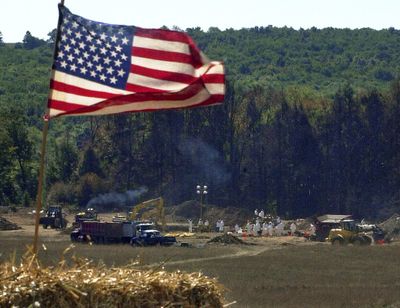Remaining wreckage of Flight 93 to be buried at Pennsylvania memorial

The remaining wreckage of United Flight 93 will be returned this year to the Pennsylvania memorial marking where it crashed in the 9/11 terror attacks, officials said Friday.
The wreckage – stored in shipping containers – will be buried in a restricted area of the park that’s accessible only to loved ones of the victims, said Flight 93 National Memorial Superintendent Stephen Clark.
“Now that we are nearing the completion of the major design components of the memorial, we are ready to return the remaining wreckage to this hallowed ground to be buried later this year,” Clark said.
The final phase of the memorial, the Tower of Voices, is a 93-foot-tall musical instrument that holds 40 wind chimes, representing the 40 passengers and crew. It will be completed in time for the 17th anniversary of the attacks.
United Flight 93 was en route from Newark, New Jersey, to San Francisco on Sept. 11, 2001, when hijackers seized control. Passengers and crew fought back and the hijackers responded by crashing the plane into the field in Shanksville, about 60 miles southwest of Pittsburgh.
Gordon Felt, president of the Families of Flight 93, said his group requested a final, thorough examination of the wreckage before it is permanently interred “in order to determine if there were any human remains or identifiable personal items.”
The park service worked with the FBI over a number of months to painstakingly examine the debris.
“We worked with the FBI and on our hands and knees we literally combed through every bit of that wreckage,” Clark said.
Workers found a number of items that will be added to the memorial collection, including an orange passenger call button.
“What that symbolizes is the amazing courage of not only the flight attendants but all the individuals on Flight 93, who took that call to action,” Clark said. “It’s such a powerful symbol of what these men and women did that morning.”
The National Park Service will release a full report of the items collected later this year and how they will be incorporated into the memorial, he said.
“It was important for us to touch everything so we knew, without a doubt, that every possible effort was made to reunite family members with any objects belonging to their loved ones,” said memorial curator Brynn Bender.
Remains of all 40 victims were identified after the crash, either through dental records, DNA or fingerprints, something that helped give a semblance of peace to family members and a way to lay their loved ones to rest, Clark said.
Three caskets of unidentified remains from the crash of United Airlines Flight 93 in a field in Shanksville, Pa., were buried at the crash site in 2011.